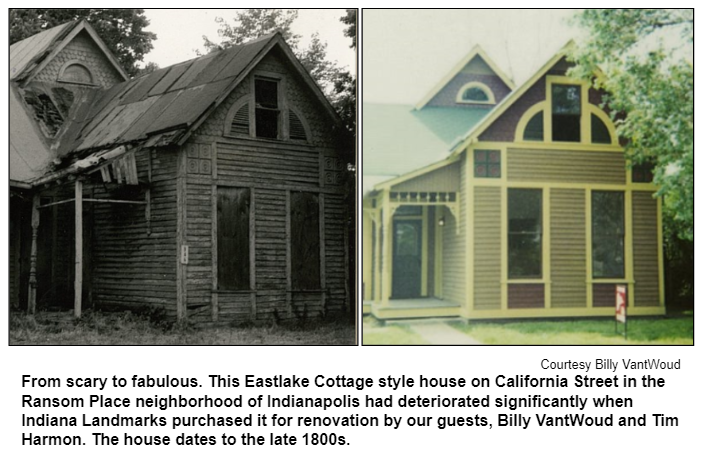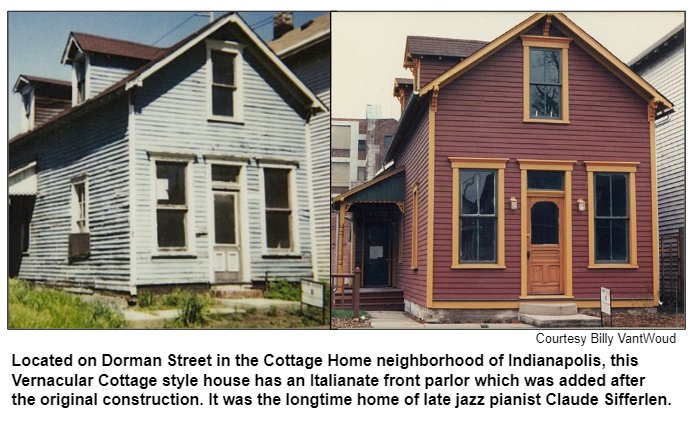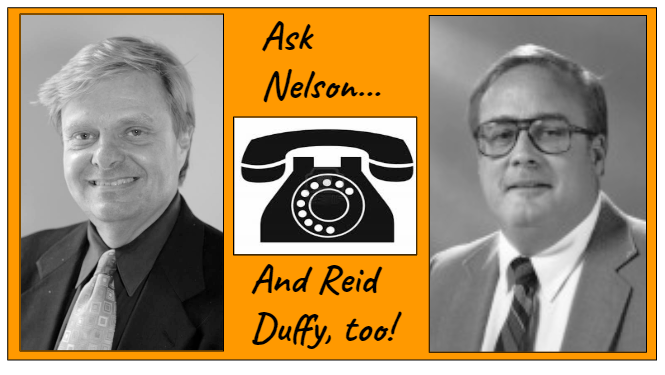
Saturdays, noon to 1 p.m. ET on WICR 88.7 FM.
Or stream audio live from anywhere on WICR Online!
You can listen to recent shows by clicking the podcast links below, or check out our extensive archive of past shows available as podcasts
September 14, 2019
Historic homes: Tips for buying, restoring and maintaining
"Sometimes an old lady deserves a few wrinkles," Billy VantWoud says, referring to historic houses.
Billy is an Indianapolis-based general contractor who has restored older homes in Woodruff Place, Cottage Home, Fountain Square, St Clair Place and other Indy neighborhoods dating back to the late nineteenth century. "If you can't tolerate a few imperfections, maybe a historic home is not for you."
Billy will join Tim Harmon, co-owner of Tim and Julie's Another Fine Mess architectural salvage and vintage wares shop, as Nelson's studio guests to share advice for potential buyers of historic homes as well as tips for maintaining and restoring them.
Beginning in the early 1970s, when many historic neighborhoods in Indy were in decline, Tim Harmon began working as a contractor, specializing in restoring houses that he calls "ultimate survivors."
During the 1990s, Billy and Tim were partners in a restoration services business. Both of them have done restoration or renovation work on houses built before the Civil War.
The craftsmanship and character of such houses entices potential buyers. "But most people, even with a historic house, want a modern kitchen and modern bathroom," Tim notes.
Our guests urge potential buyers to research how much of a historic home is the original structure as well as the type of renovations and the extent of repair work that have been undertaken in subsequent decades.
Some tidbits about our topic and guests:
- Billy, who grew up in the town of Culver in northern Indiana, lives in a Woodruff Place house built in 1901. He restored the historic house, which had been carved up to create 10 rental units.
- Tim was the Roadtripper correspondent on our Aug. 31 show, reporting on an offbeat storefront museum he operates next to his architectural salvage shop. Indy's Teeny Statue of Liberty Museum has more than 500 pieces of memorabilia depicting Lady Liberty.
- Tim offers this tip for potential home buyers who want to assess the extent that a floor has settled in a historic home: "Take a marble or ball bearing with you when you visit. Don't roll it. Just set it down on the floor, and see where it goes."
Roadtrip: The Atterbury-Bakalar Air Museum in Columbus
Great Roadtripper Skip Taylor, volunteer and docent at the Atterbury-Bakalar Air Museum in Columbus, Ind., invites us to join him on an aviation-themed Roadtrip to explore the experiences of Indiana's military and civilian personnel who served in wars and military conflicts from 1942 to 1970.
The museum is located on the former Atterbury Army Airfield, established in 1943 as an aviation training facility and adjunct to Camp Atterbury, located about 10 miles to the west. The airfield was decommissioned as an Air Force base in 1970 and now serves as the Columbus Municipal Airport.
The Atterbury-Bakalar Air Museum covers the history of World War II, plus the conflicts in Korea and Vietnam, and displays a wide variety of military hardware. Full-size exhibits include a WWII-era CG4-A glider, a cut-away Curtiss-Wright 3350 aircraft engine and two military jeeps. Scale models round out the collection and explore the broad range of Indiana aviation history. A 1960s-era F4 Phantom fighter-bomber can be viewed outside the museum building.
But Skip tells us that the real focus of the museum is on the men and women from Indiana who served in military aviation. This includes the famous Tuskegee Airmen, a group of African-American servicemen who overcame segregation and discrimination to become one of the most respected fighter groups of World War II.
You may even have the chance to meet some veterans on your visit: the volunteers who maintain the museum and guide visitors through it are largely composed of veterans and former service members.
History Mystery

Question: What is the architectural name for a type of roofed porch that leads to the entrance of a house? This type of covered porch typically is attached to the house and has columns that support the roof.
Occasionally this type of roofed porch is enclosed by walls.
Hint: In ancient Greece, these often were the entrances to temples.The call-in number is (317) 788-3314. Please do not call into the show until you hear Nelson pose the question on the air, and please do not try to win the prize if you have won any other prize on WICR during the last two months. You must be willing to give your name and address to our engineer and be willing to be placed on the air.
The prizes this week are two admissions to the Indianapolis Scottish Highland Games on October 12 in German Park, courtesy of the Scottish Society of Indianapolis, a gift certificate to Story Inn in Brown County, courtesy of Story Inn, and two admissions to James Whitcomb Riley Museum Home in Indianapolis, courtesy of the James Whitcomb Riley Museum Home.
Our reach - and our production costs - are going up!
The news is in: Hoosier History Live's expansion into podcasting is increasing our listenership by leaps and bounds!
As many of our fans have discovered, it's easy to "tune in" to our weekly radio show by accessing the podcast on apps such as Stitcher and Apple Podcasts, or wherever you download or stream your favorite podcasts. You can also "Click here to listen to the podcast" below shows listed on our archive page or at the top of the newsletter and website.
But as our podcast audience grows, so do the demands upon our Internet server and our devoted Hoosier History Live production and editing team. Our podcasts are free to listeners, of course, but they definitely cost money to create and make available to the public.
Won't you consider helping out? To make a personal donation, click on the yellow "Donate" button on our newsletter or website. We can publish your name with a big "Thank You!" or you can remain anonymous, as you prefer.
If you own a business or run an organization, please consider a sponsorship. We'll express our appreciation by featuring your business or organization's logos, links, and voiced credits in the live show and in podcasts. To arrange for a sponsorship, contact producer Molly Head at (317) 927-9101 or email her at molly@hoosierhistorylive.org.
Nelson Price, host and historian
Molly Head, producer/general manager, (317) 927-9101
Michael Armbruster, associate producer
Cheryl Lamb, administrative manager
Richard Sullivan, senior tech consultant
Pam Fraizer, graphic designer
Garry Chilluffo, special events consultant
Please tell our sponsors that you appreciate their support!

 For organizational sponsorship, which includes logos, links, and voiced credits in the show and in podcasts, contact producer Molly Head at (317) 927-9101 or email her at molly@hoosierhistorylive.org. Our podcast listens are increasing at a rate of 17% a month!
For organizational sponsorship, which includes logos, links, and voiced credits in the show and in podcasts, contact producer Molly Head at (317) 927-9101 or email her at molly@hoosierhistorylive.org. Our podcast listens are increasing at a rate of 17% a month!
Acknowledgments to Visit Indy, Fraizer Designs,WICR-FM, Henri Pensis, Aaron Duvall, Chloe Tyson, and many other individuals and organizations.
Thank you!
We'd like to thank the following recent, new and renewal contributors whose donations help make this show possible!
- Bruce and Julie Buchanan
- David Willkie
- Coby Palmer in memory of Gary BraVard
September 21, 2019 - coming up
Ask Nelson - and Reid Duffy, too
It's time for another "Ask Nelson..." show, which we've featured regulary over the eleven years Hoosier History Live has been on the air. As usual, our host, author and historian Nelson Price, is joined by a co-host, this time one who will be familiar to long-time TV viewers across Central Indiana. Reid Duffy, a popular personality for nearly 30 years on WRTV-Channel 6 in Indianapolis, will join Nelson; the two will interview each other in between phone calls from listeners.
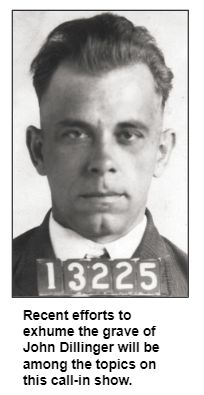
At any point during the show, listeners are invited to call in with questions for Nelson or Reid. The WICR-FM studio number is (317) 788-3314.
Although the topics covered in the show depend on listeners' call-in questions, Nelson does have an agenda. First, he plans to provide historical context about a controversial public figure who is back in the news more than 85 years after he was killed.
Bank robber John Dillinger (1903-1934) - known as "Public Enemy No. 1" during the Great Depression - has been the focus of national media attention in response to recent requests by some of his surviving family members to have his body exhumed. They were encouraged by The History Channel, which originally hoped to put together a documentary on the exhumation but recently pulled out of the project. Some family members have objected to tampering with Dillinger's burial site, located in Crown Hill Cemetery in Indianapolis.
Ever since Dillinger was shot and killed by federal agents and Chicago-area police officers, rumors have circulated that the corpse was not that of the outlaw. In Nelson's book Indiana Legends: Famous Hoosiers from Johnny Appleseed to David Letterman (Hawthorne Publishing), he describes how Dillinger took steps to alter his appearance while in hiding.
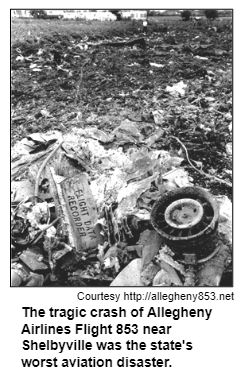
Born in the Brightwood neighborhood of Indianapolis, Dillinger lived as a teenager and young adult on his family's farm in Mooresville.
During our show, Nelson will also share insights about the 50th anniversary of one of the most tragic episodes in Indiana history. In September 1969, two aircraft collided near Shelbyville, resulting in the state's worst aviation disaster.
All of the 78 passengers and four crew members aboard an Allegheny Airlines flight traveling from Cincinnati to Indianapolis were killed when the DC-9 jet crashed into a soybean field. It plummeted to the ground after colliding with a much smaller plane, a single-engine Piper Cherokee; the pilot of that plane was also killed.
Earlier this month, a memorial was dedicated on the site of the tragedy, which also is the focus of a commemorative website.
Listener calls during our show are not restricted to history topics that have been in the news recently. Nelson and Reid will welcome questions, comments and insights about any slice of our state's heritage.
© 2019 Hoosier History Live. All rights reserved.
|
